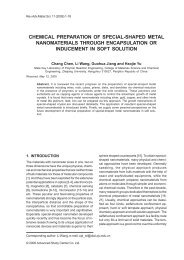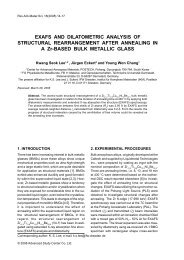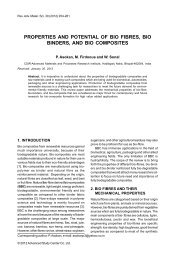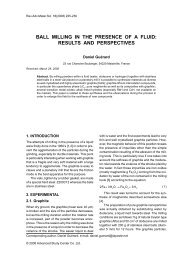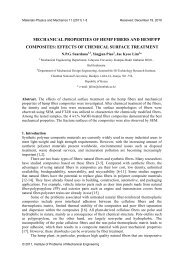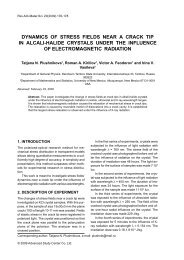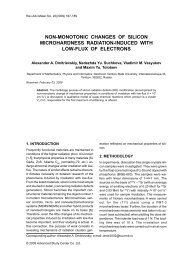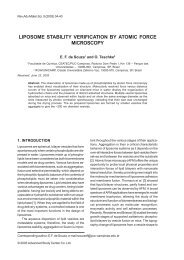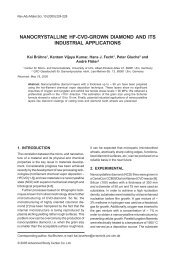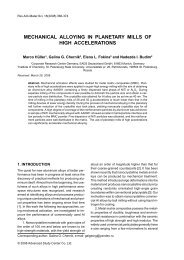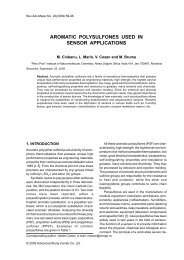surface pretreatment by phosphate conversion coatings – a review
surface pretreatment by phosphate conversion coatings – a review
surface pretreatment by phosphate conversion coatings – a review
You also want an ePaper? Increase the reach of your titles
YUMPU automatically turns print PDFs into web optimized ePapers that Google loves.
144 T.S.N. Sankara Narayanan<br />
Miyawaki et al. [199] have introduced the concept<br />
of ‘P ratio’ to express quantitatively the proportion<br />
of these phases in <strong>phosphate</strong> <strong>coatings</strong>. It is<br />
defined as:<br />
Phosphophyllite<br />
‘P ratio’ = Phosphophyllite + Hopeite<br />
Several authors [199,200] have correlated the ‘P<br />
ratio’ and corrosion resistance of the <strong>phosphate</strong><br />
coating. But according to Richardson et al. [200]<br />
the ratio itself is not sufficient to predict the corrosion<br />
resistance.<br />
X-ray and electron diffraction studies have shown<br />
that hopeite and phosphophyllite are oriented perpendicular<br />
to the plane of the support besides<br />
exhibiting that there is an excellent orientation between<br />
the substrate and the zinc <strong>phosphate</strong> coating<br />
that follows an epitaxial growth relationship.<br />
(010) - hopeite and (100) - phosphophyllite || (100)α-Fe<br />
(100) - hopeite and (001) - phosphophyllite || A o -α-<br />
Fe and<br />
(001) - hopeite and (010) - phosphophyllite || A o -α-<br />
Fe<br />
The formation of primary valency bonds between<br />
the coating and the polarized elements of the α-iron<br />
lattices with the production of a two dimensional<br />
contact layer of the wustite-type accounts for the<br />
excellent adhesion of the coating to the substrate.<br />
3.6.2. Coating thickness and coating<br />
weight<br />
One of the principal factors involved in the choice of<br />
a phosphating bath is in fact the thickness of the<br />
deposit that it will provide. Neglecting intercrystalline<br />
voids and <strong>surface</strong> irregularities and considering the<br />
<strong>phosphate</strong> coating as completely homogeneous, the<br />
thickness can be measured [201]. Phosphate <strong>coatings</strong><br />
range in thickness from 1 to 50 microns but for<br />
practical purposes the thickness is usually quantified<br />
in terms of weight per unit area (usually as g/m 2<br />
or mg/ft 2 ) and commonly referred to as coating<br />
weight. The reason for the adoption of coating weight<br />
rather than coating thickness as the usual measure<br />
of <strong>coatings</strong> is the difficulty in measuring the<br />
latter, compounded <strong>by</strong> the uneven nature of the substrate<br />
and of the coating.<br />
According to Lorin [127] the ratio between coating<br />
weight (g/m 2 ) and coating thickness (μm) varies<br />
between 1.5 and 3.5 for the majority of industrial<br />
<strong>phosphate</strong> <strong>coatings</strong>. For light and medium weight<br />
<strong>coatings</strong> 1 μm can be regarded as equivalent to 1.5-<br />
2 g/m 2 .<br />
The determination of coating weight is a destructive<br />
test, which involves weighing a standard test<br />
panel before and after stripping the coating in a<br />
medium, which dissolves the coating and not the<br />
substrate. Usually methods such as stripping the<br />
coating in concentrated hydrochloric acid containing<br />
antimony trioxide (20 g/l) as an inhibitor or high<br />
concentration of chromic acid solution (5%) or sodium<br />
hydroxide (15%) is used. A non-destructive<br />
method based on specular reflectance infrared absorption<br />
(SRIRA) for the determination of zinc <strong>phosphate</strong><br />
coating weight has been developed <strong>by</strong> Cheever<br />
[202, 203]. Tony Mansour [204] has shown a good<br />
agreement of the results obtained <strong>by</strong> this method<br />
with X-ray fluorescence (XRF) data as well as the<br />
gravimetric measurements. Yap et al. [205] suggest<br />
that XRF is a nondestructive and accurate technique<br />
for measuring the thickness of thin <strong>phosphate</strong> <strong>coatings</strong>.<br />
The phosphating industry generally uses coating<br />
weight as a method of quality control; but it is<br />
widely agreed that except at extreme values, coating<br />
weight does not directly relate to corrosion performance.<br />
Hence coating weight alone is of little<br />
value in assessing the quality of <strong>coatings</strong> and must<br />
be considered in relation to other characteristics of<br />
the <strong>coatings</strong>, viz., thickness, structure homogeneity,<br />
etc.<br />
3.6.3. Coating porosity<br />
The layer of <strong>phosphate</strong> coating consists of numerous<br />
crystals of very different sizes, which have<br />
spread from centers of nucleation to join and finally<br />
cover the <strong>surface</strong>. A constitution of this type inherently<br />
implies the existence of fissures and channels<br />
through to the basis metal at inter-crystalline<br />
zones. Porosity is generally fairly low, of the order<br />
of 0.5-1.5% of the <strong>phosphate</strong>d <strong>surface</strong> [25]. It is<br />
generally believed that the porosity decreases with<br />
increasing thickness of the <strong>phosphate</strong> coating. Porosity<br />
depends upon the type of <strong>phosphate</strong> solution,<br />
the treatment time, the iron content of the bath<br />
and, the chemical composition of the coating [206].<br />
In recent years, much attention has been focused<br />
on the porosity of <strong>phosphate</strong> <strong>coatings</strong> due to the<br />
presence of tightly bound carbonaceous residues<br />
formed on steel during steel making [207]. Since<br />
these cannot be removed <strong>by</strong> alkaline cleaning process,<br />
they interfere with the effective deposition of<br />
<strong>phosphate</strong> <strong>coatings</strong> resulting in the formation of<br />
porous <strong>coatings</strong> with inferior performance.<br />
Several chemical and electrochemical methods<br />
have been developed to determine the porosity of



